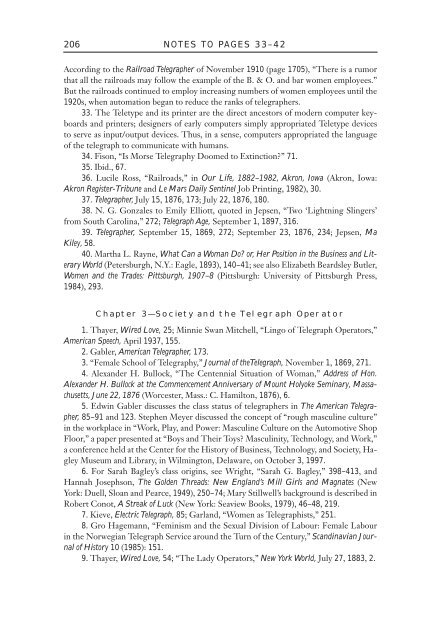My Sisters Telegraphic: Women in the Telegraph Office ... - Monoskop
My Sisters Telegraphic: Women in the Telegraph Office ... - Monoskop
My Sisters Telegraphic: Women in the Telegraph Office ... - Monoskop
You also want an ePaper? Increase the reach of your titles
YUMPU automatically turns print PDFs into web optimized ePapers that Google loves.
206<br />
NOTES TO PAGES 33–42<br />
Accord<strong>in</strong>g to <strong>the</strong> Railroad <strong>Telegraph</strong>er of November 1910 (page 1705), “There is a rumor<br />
that all <strong>the</strong> railroads may follow <strong>the</strong> example of <strong>the</strong> B. & O. and bar women employees.”<br />
But <strong>the</strong> railroads cont<strong>in</strong>ued to employ <strong>in</strong>creas<strong>in</strong>g numbers of women employees until <strong>the</strong><br />
1920s, when automation began to reduce <strong>the</strong> ranks of telegraphers.<br />
33. The Teletype and its pr<strong>in</strong>ter are <strong>the</strong> direct ancestors of modern computer keyboards<br />
and pr<strong>in</strong>ters; designers of early computers simply appropriated Teletype devices<br />
to serve as <strong>in</strong>put/output devices. Thus, <strong>in</strong> a sense, computers appropriated <strong>the</strong> language<br />
of <strong>the</strong> telegraph to communicate with humans.<br />
34. Fison, “Is Morse <strong>Telegraph</strong>y Doomed to Ext<strong>in</strong>ction?” 71.<br />
35. Ibid., 67.<br />
36. Lucile Ross, “Railroads,” <strong>in</strong> Our Life, 1882–1982, Akron, Iowa (Akron, Iowa:<br />
Akron Register-Tribune and Le Mars Daily Sent<strong>in</strong>el Job Pr<strong>in</strong>t<strong>in</strong>g, 1982), 30.<br />
37. <strong>Telegraph</strong>er, July 15, 1876, 173; July 22, 1876, 180.<br />
38. N. G. Gonzales to Emily Elliott, quoted <strong>in</strong> Jepsen, “Two ‘Lightn<strong>in</strong>g Sl<strong>in</strong>gers’<br />
from South Carol<strong>in</strong>a,” 272; <strong>Telegraph</strong> Age, September 1, 1897, 316.<br />
39. <strong>Telegraph</strong>er, September 15, 1869, 272; September 23, 1876, 234; Jepsen, Ma<br />
Kiley, 58.<br />
40. Martha L. Rayne, What Can a Woman Do? or, Her Position <strong>in</strong> <strong>the</strong> Bus<strong>in</strong>ess and Literary<br />
World (Petersburgh, N.Y.: Eagle, 1893), 140–41; see also Elizabeth Beardsley Butler,<br />
<strong>Women</strong> and <strong>the</strong> Trades: Pittsburgh, 1907–8 (Pittsburgh: University of Pittsburgh Press,<br />
1984), 293.<br />
Chapter 3—Society and <strong>the</strong> <strong>Telegraph</strong> Operator<br />
1. Thayer, Wired Love, 25; M<strong>in</strong>nie Swan Mitchell, “L<strong>in</strong>go of <strong>Telegraph</strong> Operators,”<br />
American Speech, April 1937, 155.<br />
2. Gabler, American <strong>Telegraph</strong>er, 173.<br />
3. “Female School of <strong>Telegraph</strong>y,” Journal of <strong>the</strong><strong>Telegraph</strong>, November 1, 1869, 271.<br />
4. Alexander H. Bullock, “The Centennial Situation of Woman,” Address of Hon.<br />
Alexander H. Bullock at <strong>the</strong> Commencement Anniversary of Mount Holyoke Sem<strong>in</strong>ary, Massachusetts,<br />
June 22, 1876 (Worcester, Mass.: C. Hamilton, 1876), 6.<br />
5. Edw<strong>in</strong> Gabler discusses <strong>the</strong> class status of telegraphers <strong>in</strong> The American <strong>Telegraph</strong>er,<br />
85–91 and 123. Stephen Meyer discussed <strong>the</strong> concept of “rough mascul<strong>in</strong>e culture”<br />
<strong>in</strong> <strong>the</strong> workplace <strong>in</strong> “Work, Play, and Power: Mascul<strong>in</strong>e Culture on <strong>the</strong> Automotive Shop<br />
Floor,” a paper presented at “Boys and Their Toys? Mascul<strong>in</strong>ity, Technology, and Work,”<br />
a conference held at <strong>the</strong> Center for <strong>the</strong> History of Bus<strong>in</strong>ess, Technology, and Society, Hagley<br />
Museum and Library, <strong>in</strong> Wilm<strong>in</strong>gton, Delaware, on October 3, 1997.<br />
6. For Sarah Bagley’s class orig<strong>in</strong>s, see Wright, “Sarah G. Bagley,” 398–413, and<br />
Hannah Josephson, The Golden Threads: New England’s Mill Girls and Magnates (New<br />
York: Duell, Sloan and Pearce, 1949), 250–74; Mary Stillwell’s background is described <strong>in</strong><br />
Robert Conot, A Streak of Luck (New York: Seaview Books, 1979), 46–48, 219.<br />
7. Kieve, Electric <strong>Telegraph</strong>, 85; Garland, “<strong>Women</strong> as <strong>Telegraph</strong>ists,” 251.<br />
8. Gro Hagemann, “Fem<strong>in</strong>ism and <strong>the</strong> Sexual Division of Labour: Female Labour<br />
<strong>in</strong> <strong>the</strong> Norwegian <strong>Telegraph</strong> Service around <strong>the</strong> Turn of <strong>the</strong> Century,” Scand<strong>in</strong>avian Journal<br />
of History 10 (1985): 151.<br />
9. Thayer, Wired Love, 54; “The Lady Operators,” New York World, July 27, 1883, 2.

















